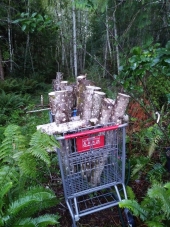Hello Priscilla,
It's not so much space, as it is available forage, and that available forage changes with the seasons, in addition, to other environmental factors, like unusual changes, droughts or extreme temperatures which effect vegetative regrowth. Forage is measured in animal unit months or AUMs, meaning enough forage dry matter and digestible nutrients/protein to sustain the average cow for 1 month. There is even an average weight around 1000 lbs if I'm not mistaken, and a AUM equals about 25 lbs of adequate dry matter forage per day for one month. Dry matter means dry forage with no moisture, and this dry matter forage must be quality enough with digestible nutrients and protien content enough to sustain a healthy cow. Of course different animals have different needs, so sometimes certian animals like Bison do better on lower protien contents, meaning what may be considered low quality hay for a beef cow, will be adequate for a Bison, so knowing your spacific species and or breeds exact nutritional needs, can help asses if your available forage will be adequate. There are averages and conversions, that let you know baised on average weight, how many sheep, goats or other animals will average one AUM. Most herdsmen get good at evaluating standing forage, and will base each grazing rotation length on the forage in the paddock when they turn the livestock out in that feild. You can measure a feilds dry matter content, by cutting and drying a measured proportion, to the desired graze hight, then drying it in an oven, to weigh the dry matter, and multiplying your test area, to meet the dimensions of your full paddock.
Once you know your dry matter content of the particular paddock, you will know how many AUMs you have, at that point in time. Then evaluating the different forage species, their average percent of the given dry matter they make up, and their individual nutritional values, like digestible nutrients and protien content: which typically all very depending on the different forage crops stage of growth. You can then asses if you will need suplemental feed, to make up the difference in any nutritional short comings of that paddocks available forage.
If you use the same large paddock, like say 10 wide open acers, for 10 goats, the goats will over graze the desirable forage species, and change the pasture dynamic, which typically destroys the feild quality and biodiversity in your pastures. This is why most people are switching over to rotational mob grazing, with daily paddocks that have one days forage. Goats left to their own devices, will over graze browse species, and those shrubs will die off.
I personally can't answer your question, without knowing your exact environment, and even the uniqueness of every individual season as it comes, including the types of forage available, and their individual stages of growth relating to nutritional quality; however, hopefully I've pointed you in the right direction to calculate that for yourself, and how to best manage your feilds, to maximize forage, by using rotational mob grazing, which alows lots of healthy regrowth before regrazing, while still keeping forage quality high.
If the goats average about 100 lbs each, the10 goats, depending on their size and breed, equals about 1 AUM, but remember breed can dictate needed forage quality. So dairy goats, like many conventional breeds, won't do well on all forage, as they need high quality feeds; however, there is one meat breed that does well on all forage, and its the Kiko goat.




